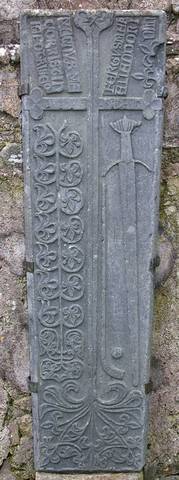SIMILAR IMAGES
IMAGE INFORMATION
EditThe depiction of Gaelic sport on any stone monument is very rare and there are only a couple in Ireland depicting sport which makes the slab unique. Slabs and crosses were mainly for funerary use or for religious sites, not for sport.
In the book 'Ancient Monuments of Inishowen, North Donegal', it has been written, “This is one of the very rare examples of Scots- Gaelic to be seen on an Irish monument and illustrates the close links that existed between this peninsula and Scotland. Circa 1400, lands in this area were available for distribution and members of the Mac Allan clan were given grants of territory as a reward for their military services in helping O’Doherty gain control of the peninsula. The symbols on the stone slab in the church are reminders of the warlike and sporting skills of the family. The name Mac Orristin (McCorristin) was also well known in this monastry (Cloncha). In 1431 the name of the rector was Cornelius Mac Orristin, and there were other rectors of the same name in the sixteenth century.
In Inishowen, camán was a popular winter sport enjoyed by the gentry and ordinary folk particularly in post-medieval times. There was a great tradition in Inishowen of playing the game on Christmas Day between rival townlands. Even in the nineteenth century it crossed political and social boundaries. There was no fixed pitch and the game traversed from one townland to another using a home-made sliotar.
Of transnational relevance is the fact that the stone is a celebration of Hiberno-Scottish culture in a number of ways. The deceased was from the Isles of Scotland. The Norsemen occupied these territories and it was from them that Magnas got his Christian name: an authoritative link beween Inishowen, Scotland and the Norse sagas. The inscription is in Scots Gaelic and is one of the rare examples of such writing on public memorials to have survived. The sword has been indentified as a two-handed Scottish claymore, a crude weapon of medieval warfare, commonly used in the most brutal phase of battle. The Scottish connections are many: the first Methodist ministers here preached to their congregations in Scots-Gaelic. Indeed the stone can also be placed in the context of the Ulster-Scots heritage.

